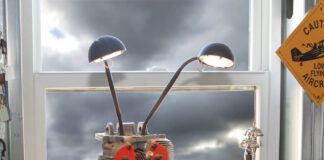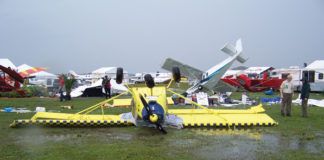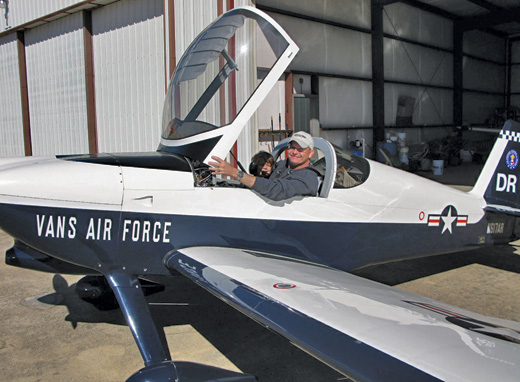
The author poses happily in his airplane.
Editor’s note: Last month we ran a piece on flight safety by Richard VanGrunsven of Van’s Aircraft. We thought we’d follow that up with another view on safety from a well-known Van’s enthusiast, Doug Reeves.
If you’ve ever seen the movie Office Space, you will understand what I mean when I say that I worked in a similar environment to the one shown in the film for more than a decade. (You can see a trailer on YouTube).
As a matter of fact, 10 minutes into the movie you can see the actual building I worked in. I’ve been doing the Van’s Air Force forum full-time since April 2007, but I still keep in close touch with several of my former coworkers. They are great friends, and some have become pilots. A few have even started building RVs. This is written with them in mind, but could be appreciated by any person I may have influenced into “RVating” over the years.
Being the original “airplane guy” in the I.T. department of a company was pretty nice. I’m honored that some of my coworkers got their pilot’s licenses and started building their own RVs after watching me build and fly mine. Because many of them had the same sort of background as I do (non-military/non-airline), and because I’m now about a decade further down the road in flying experience, I thought I’d take a moment to jot down some thoughts on how my flying style has changed over the last 10 years, and how I have become much more conservative and safety oriented in my flying.
As some readers may know, I took a vacation day from the office to witness the first flight of my Van’s RV-6. A few days later I flew it myself and thought I was Bob Flippin’ Hoover. That was in September of 2002. Looking back, I may have come across as knowing it all there in the office. That was for show. It turns out I didn’t know what I didn’t know. I’ve learned so much more over these last 1000 hours in the air that I’d like to offer you some advice. I hope you’ll take it in the spirit in which it is offered; I want to have you around as long as possible.
Over the course of the last decade hanging around with ex-military types and 30,000+ hour airline pilots, and listening to how they talk, fly and act, I have gravitated toward a more conservative flying mindset. It is said the rules that airline and military pilots fly by are written in blood. What I’ve come to realize is that how I act might influence how others think about flying. How I fly may influence them more.
Some of you may be put off by what I’m about to say, but I hope not. Will begging you to fly more safely save your life someday? I hope so. On with the list of my current personal limits.
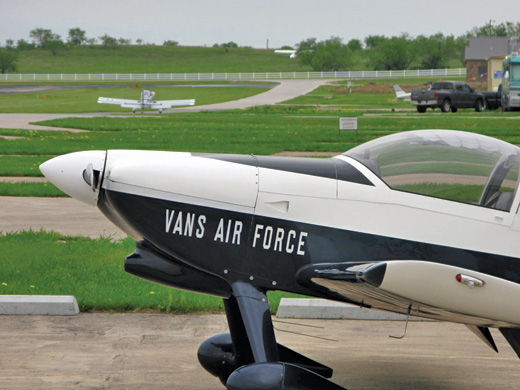
Note the Cessna in the trees in the background. It had an engine problem, and upon landing the nosegear collapsed.
Things I Will and Won’t Do in a Small Airplane
No single-engine night flying. The law allows it, but my comfort level now doesn’t. A single-engine, deadstick landing in the dark isn’t something I want in my logbook. I have ex-military friends with hundreds of night carrier landings who won’t fly their RVs at night. What do they know that I don’t? That 10,000-foot runway over at KAFW with high-intensity lights is a breeze to land on at night. The tiny, barely lit runway at my home field, the one I have to return to, is darn scary in the flare.
•No high-speed low passes down the runway. I’m mortified to say that I’ve done this a couple of times, albeit around eight years ago. Never again. I was an idiot. I’ve seen pilots do this occasionally, scaring up flocks of birds that missed the plane (and the pilot’s head) by 2 feet.
•An A&P/IA does my yearly inspection. I’m not an airplane mechanic (and neither are most of you). I’m no longer comfortable betting my life on what I think looks right. While it is legal for me to do these inspections, I now choose not to. I take all of the panels off, pull the cowl and give a good look using the checklist, and then my A&P/IA comes over for a few hours. He always finds something I missed. A few hundred bucks to have a professional look over my shoulder is money well spent by this former cube worm. My wife thinks so, too. Many of you are higher up in the org chart than I was and have fewer kids, so I know you can probably afford it.
•An A&P/IA supervises (or does) all of my firewall-forward work. It’s the part of the build with the least amount of documentation (as you may be finding out), and I am legally allowed to do 100% of it. However, I’m also leaving that to the professionals. I don’t touch a thing, or button it back up, without the OK of my A&P/IA. “Hey, I just changed the oil. Can you come over here for 5 minutes and give everything a look-see before I button it up? Lunch is on me.” Sometimes it’s as simple as that. Do I know more about aircraft engines than he does? No. Am I willing to bet my life on it? No! The lives of my wife and children? No! A reliable engine is life, and I’ve had a couple go stupid on me in the last two decades. It will change your whole outlook if/when that happens. I don’t skimp or get too “experimental.”
•I don’t fly in aircraft that have car engines in them. And I don’t drive cars powered by aircraft engines, either. I admire those gearheads, but I’m not one of them. I know you aren’t either. Please don’t do it.
•No flying in shorts, flip-flops or nylon. I fly nearly every other day. Short, local flights with lots of power changes and touch-and-goes (averaging one landing each day in the first four months of 2011). Due to the nature of my job, I’m inclined to think I log more takeoffs and landings than the average GA pilot, so I’m around more avgas and 1300° F exhaust pipes than most. Most days now I wear blue jeans and a long-sleeve Nomex racing undershirt as my flying uniform. If the undershirt is in the wash, a long-sleeve cotton shirt will do. If shorts are called for before and after the flight, I slip on a Nomex flight suit over the shorts (no T-shirt). It takes 30 seconds. I wear Nomex gloves on all flights and cotton or Nomex socks. When I get out of the airplane I change back into normal clothes, carried around in a nylon helmet bag that a friend gave me.
I don’t wear them to look Top Gun cool, and I don’t have patches or a name tag slapped on. I wear them to keep from needing a square yard of grafted cadaver skin, if it takes more than a few seconds to get out of a burning plane. Google “third-degree burns” and click on the images if you haven’t eaten yet. I want to keep my fingers and original skin if at all possible should things go wrong. And, yes, I’ve had more than one friend burn to death. Passengers are offered a set of gloves, and I keep a spare long-sleeve cotton shirt in the flight bag. I don’t sugarcoat it. “Those are fuel lines running under our knees, and that one over there, just under your right knee, is pressurized.” I don’t anticipate any problems, but it never hurts to be better prepared. Our 10-year-old son has “flying clothes” that he keeps on the shelf ready and waiting: a long-sleeve cotton shirt, long pants, cotton socks, cotton baseball cap and Nomex gloves. He thinks they are cool. I think so, too. Make fun of me if you want, but I’m wearing the gloves. On every flight. If you want to be my passenger, you’re in similar gear or you’re staying on the ground. My plane, my rules.
•No long, solo direct legs without flight-following. You remember surfing the news stories about Steve Fossett.
•No listening to loud music in congested airspace. If the airline guys get fired for doing it, I shouldn’t be doing it either when PIC. I’m under the same Class B veil as they are most of the time. If you want music playing softly in the background, I’m not going to judge. Just make sure you can hear my radio call.
•Thirty minutes of VFR fuel is not enough; I flight-plan for 60 minutes, and you should, too. The gauges aren’t accurate enough to bet your life on them.
•No massive, multi-element formations. No formation acro. It both looks and sounds amazing, but gargantuan formations are too risky for my comfort level now. I am qualified, and have a F.A.S.T. formation card in my wallet that I got through the Globe Swift gang on my field. But these days I stick to the occasional academic, one- to three-element flights for proficiency, with people whose flying skills I am completely familiar with. No impulsive formation flights without a proper and thorough briefing. Absolutely no formation acro at all.
Why the turnaround? The answer came, for me, with a little research. Professional, full-time, “recognized as the best of the best” military aerobatic teams like the Blue Angels and Thunderbirds, with hand-picked members, bump and trade paint on a somewhat regular basis. But here’s what they have going for them that we don’t: 1) They sit on ejection seats; 2) they don’t have 72-inch spinning circular saws on the front of each jet; and 3) they practice their routines literally six days a week instead of sitting in front of a computer like many of us do. Even so, some have died over the years, more than you would think. Our RVs don’t bump and trade paint very well on account of the propellers. Color me impressed at the skill set, but politely passing on the offer. When I see the mass flights go over at airshows I’m cheering, but I’m also saying a prayer.
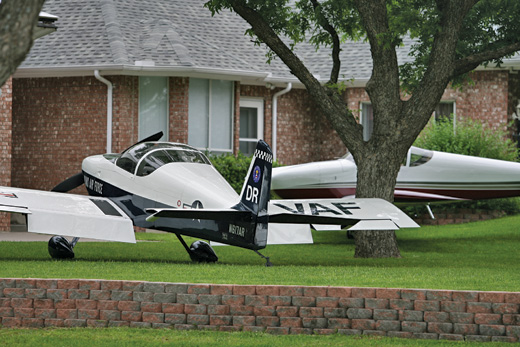
The steeds graze in front of the house, waiting for the chance to fly again.
Playing by the Rules
I’m currently getting an instrument rating, and you should, too. I’m not rushing it, no weekend cram course. I want to understand it completely, not just pass a test. When I get the rating, there will be no “hard” single-engine IFR flying. By hard I mean flying out of, over or into areas of low-IMC conditions. If the engine quits and you have to dead-stick into a location where the weather is 300 feet overcast, you are going to get to do a controlled glide to a crash, probably not a forced landing.
If I witness you blatantly breaking the FARs in the U.S., I will bring it to your attention. If I see you doing the same thing a second time, I will report you to the authorities. If you post a video of yourself blatantly breaking the FARs somewhere and link to it in my forums, I will delete the post and immediately forward the YouTube link to the appropriate authorities. Friends or not, we have to police ourselves better in general aviation. When you signed that pilot card in your wallet you agreed to fly by the rules. I’ll go one further and make you a deal: If you won’t post videos of yourself blatantly violating the FARs in my place of business (while trying to guilt me into not reporting it), then I won’t place a TV showing a video loop of me robbing a liquor store in the lobby of your place of business. Deal? Swell. Here are the FAR violations I do not want to see posted in my forums:
• Video of acro with a passenger and no parachutes.
• Dodging in and out of clouds when it’s obvious you’re VFR.
• High-speed low passes.
• Acro where you can see dozens of houses in the shot.
You can find the FAA regulations online here: www.faa.gov/regulations_policies/faa_regulations.
You can probably tell by the bullet points noted above that I don’t sell airplanes for a living. I don’t spin this hobby as one in which you can’t get hurt. It is the most amazing and satisfying hobby I’ve found, but it can kill you in 5 seconds if you’re not careful. You have to try pretty hard to die on a golf course or when fishing. While flying small airplanes, it takes no effort at all if you have the wrong mindset.
With the right attitude, and admitting that you just might not know what you don’t know, you can minimize that risk to a surprisingly small percentage. I’m taking steps, active steps that all can see, to hopefully fly safely into my late 70s or early 80s. I’d like you to do the same.
A link to this document now exists in my email auto-signature and in the profile of all the online boards I visit. I encourage you to create your own RV Safety Culture document and link to it in everything you do online. We as a group need to spread the words “RV Safety Culture” around a lot more, and we need to lead by example.
And if I do something stupid or dangerous, I expect you to call me on it.

![]()
Doug Reeves built his Van’s RV-6 from 1996 to 2002 and currently has a little more than 1000 flying hours in it. Starting in 1997, while working a corporate job, he created www.VansAirForce.net in the evenings. In 2007, he resigned from life in a cubicle and now runs the web site full-time. He lives north of Dallas, Texas, with his wife, daughter, son and a Chihuahua named Moondog.




